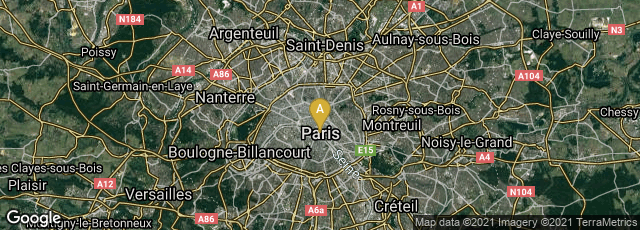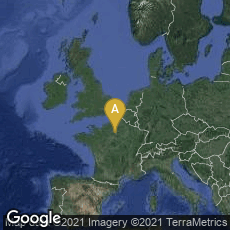

A: Paris, Île-de-France, France
It took Jacques de Vaucanson took the seven years between 1731 and 1738 to design and construct his first automaton, or android— The Flute Player. Vaucanson's Flute Player was most probably the first automaton to perform a series of mechanical procedures long enough and complex enough to provide a credible imitation of life. When finally completed the automaton was "a life-size figure of a shepherd that played the tabor and the pipe and had a repertoire of twelve songs." Vaucanson presented The Flute Player at the Académie Royale des Sciences in 1738, and published a pamphlet in Paris entitled Le mécanisme du fluteur automate, presenté a messieurs de L'Académie Royale des Sciences. Avec la description d'un canard artificial, mangeant, beuvant, digerant & se vuidant, épluchantses aîles & ses plumes, imitant en div. maniers un canard vivant. . . .
Vaucanson completed his Canard digérateur or Digesting Duck, an automaton that imitated or simulated the process of eating kernels of grain, of digestion, and of defecation in 1738.
"The duck had over 400 moving parts in each wing alone, and could flap its wings, drink water, digest grain, and defecate. Although Vaucanson's duck supposedly demonstrated digestion accurately, his duck actually contained a hidden compartment of 'digested food', so that what the duck defecated was not the same as what it ate; the duck would eat a mixture of water and seed and excrete a mixture of bread crumbs and green dye that appeared to the onlooker indistinguishable from real excrement. Although such 'frauds' were sometimes controversial, they were common enough because such scientific demonstrations needed to entertain the wealthy and powerful to attract their patronage. Vaucanson is credited as having invented the world's first flexible rubber tube while in the process of building the duck's intestines. Despite the revolutionary nature of his automata, he is said to have tired quickly of his creations and sold them in 1743" (Wikipedia article on Jacques Vaucanson, accessed 05-20-2013).
Vaucanson's Canard digérateur was the first automaton to simulate biological processes. In 1742 Vaucanson's flute-player and his duck were exhibited at the Opera House in the Hay-Market in London. In association with that exhbition. Vaucanson's booklet describing the automata was translated into English by J. T. Desaguliers and published as An Account of the Mechanism of an Automaton, or Images Playing on the German Flute. As it was Presented in a Memoire, to the Gentlemen of the Royal-Academy of Sciences at Paris. By M. Vaucanson, Inventor and Maker of the Said Machine. Together with a Description of an Artificial Duck, Eating, Drinking, Macerating the Food, and Voiding Excrements, Pluming Her Wings, Picking Her Feathers, and Performing Several Operations in Imitation of a Living Duck: Contrived by the Same Person. As Also That of Another Image, No Less Wonderful Than the First, Playing on the Tabor and Pipe ; as He Has Given an Account of Them Since the Memoire was Written. Translated Out of the French Original, by J.T. Desaguliers, L.L.D.F.R.S. Chaplain to His Royal Highness the Prince of Wales.